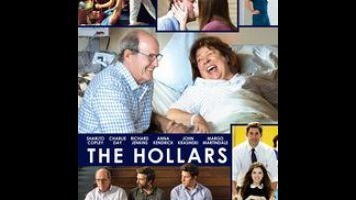John Krasinski’s The Hollars drowns out its best details with acoustic droning

During the opening five or 10 minutes of The Hollars, three different tasteful acoustic-guitar songs play on the soundtrack. Or maybe it’s the same song, played three times; it’s hard to tell, and the Josh Ritter score only confuses matters further. John Krasinski’s second feature has such a milquetoast, melancholy-indie sound that its most arresting and dynamic musical moment comes when three characters unexpectedly break into “Closer To Fine” by the Indigo Girls.
Those three men are John Hollar (Krasinski), his brother Ron (Sharlto Copley), and their father Don (Richard Jenkins), and just as it’s hard to tell the soundtrack’s songs apart, it’s never clear whether the rhyming character names are supposed to show organic cutesiness within this particular family or the forced cutesiness of screenwriter Jim Strouse. John has returned to his unspecified home—it’s a small town and it’s nowhere near his New York City home—to visit his mother Sally (Margo Martindale), who has recently been diagnosed with a brain tumor. John’s trips to wherever his family lives are rare, and as Ron repeatedly points out, he “never calls,” though no one explains why it is that, over a decade into the social media era, John not calling his parents is somehow the reason he doesn’t know, say, that his high-school girlfriend Gwen (Mary Elizabeth Winstead) has married a nurse (Charlie Day) who is tending to his mother in the hospital.
Briefly, The Hollars seems to be setting up an ill-advised love triangle where an angsty guy unsatisfied with his life feels sad and torn between Winstead and Anna Kendrick, who plays Becca, John’s loyal, helpful, good-natured, and pregnant girlfriend back in New York. To its credit, the movie sidesteps this self-pitying dilemma during Winstead’s single scene, and buckles down to explore family dynamics and regrets instead. But Kendrick still throws the movie off, mostly by giving it her best: She’s so likable, and plays the stock concerned-girlfriend part with so much sweetness and honesty, that the quirky family dramedy material plays even more false in her presence.
That’s not to say the other cast members are at fault. Jenkins and Martindale have that character-actor familiarity that makes them convincing parental figures. Jenkins even goes so far as to overact a little, presumably to match his behavior with his onscreen son Copley, who spends a fair amount of the movie playing Ron as the world’s dumbest man, only without any of the laughs that description might imply. Ron, saddled with Copley’s pinched, guttural sputter of an American accent, is such a generic fuck-up that the movie has a hard time making him work as a specific person; it just chalks up his every stupid decision to his love for his daughters. Faced with actors pushing too hard, Krasinski seems to react as a fellow performer rather than a director. Instead of tightening the reins on Copley or Jenkins, he recedes into deadpan affectations, which basically amount to saying “wait, what?” at different volumes.
Yet despite all of this, and because it’s difficult for many of these actors to be less than compelling, The Hollars never fully descends into indie-quirk hell. It has some details that ring perfectly true, like the way Sally and Ron watch and comment on real estate reality shows, or the way John’s eyes drift to the new teenagers who now populate the parking lots of his hometown, or how both John and Ron have the same idea for what treat to bring their mother in the hospital. Sometimes, this tenderness translates to an actual scene, as when John shaves his mother’s head in preparation for her surgery. This moment is accompanied, of course, by more acoustic guitar music. Whenever the movie starts to get genuinely idiosyncratic, it reverts to singing the same old songs: weddings, funerals, births, and tasteful finger-picking.